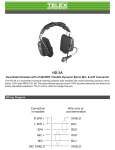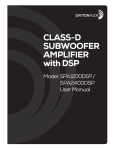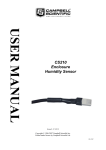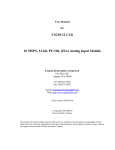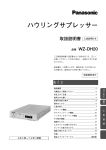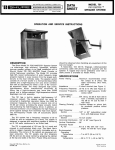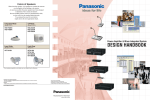Download 0 - Clear-Com
Transcript
CS-21 O/MS-200B Two Channel Main Stations INSTRUCTION and SERVICE MANUAL * pp Clear-Co Intercom Systems 945 Camelia St. * Berkeley, California 94710*415-527-6666 Clear-Com 810009 4/88 REV. C MODEL CS-210/MS-200B MAIN STATION OPERATION MANUAL I. II. III. INTRODUCTION A. The Clear-Com Concept B. The CS-210/MS-200B SYSTEM INTERCONNECTION What Cable to Use A. Inputs & Outputs: Portable Installation Cable Permanent Installation Cable Multiple Power Sources Loop-Through Set Up Signaling Configuration Interconnection Procedure B. C. Typical Two-Channel Systems I 2 5-7 8 9 OPERATION A. Front Panel Controls & Connectors B. Rear Panel Controls & Connectors C. Warranty & Maintenance 11 14 17 IV. TROUBLE-SHOOTING 18 V. CS-210/MS-200B SPECIFICATIONS 20 VI. CS-210/MS-200B PARTS LISTING 21 SYSTEM SCHEMATICS NOTICE: While Clear-Com makes every attempt to maintain the accuracy of the information contained in its product manuals, the information is subject to change without notice: . . ADDENDUM TO CS-210/MS-200B MANUALA- REV.8 The program feed has been modified to provide separate level adjustment for each intercom channel. The discussion about Program Volume on page 11 is therefore incorrect and should be replaced by the following: PROGRAM VOLUME: The "Program Volume" knob controls only the program level heard in the station's headset output. This control does not affect the level of program sent to the intercom lines. A switch on the rear panel selects which of the intercom channels program will be sent on. Individual trimpots permit independent adjustment of the program level fed to the selected channel(s), without affecting PGO level in the CS-210's headset output. The trimpots are temporarily internally adjustable. They are located directly next to the "Monitor Select" buttons on the PC board. 0 5 If program is not wanted in either channel, the trimpots should be set fully CCW. hIC TO LINE GAIN LEVEL INCREASE In effecting a 4dB Hic to Line increase in gain level, the following changes have been made: Change: At: To: 27K OHM R66, R67 43K OHM 1.5K OHM R31 2.7K OHM CSMSADD. DOC-REV. N 0 11/17/87 1 * * 40 * * * 40 INTRODUCTION A. THE CLEAR-CON CONCEPT Clear-Con is a closed-circuit intercom system that provides high intelligibility, two-way communications in high- or low-noise environments. A basic intercom system contains a one- or multi-channel Main Station interconnected with various remote headset and speaker stations. Clear-Com manufactures a wide variety of portable, rack-mount, and custom-mount intercoms. All are compatible, allowing systems to be set up according to specific needs. The Clear-Com System interfaces with virtually any other type of communications systems (call ClearCon or see your dealer for info. ) * * I. a 5 Clear-Con Stations normally interconnect with standard, 2-conductor shielded microphone cable; they include inputs for XLR-type, 3-pin connectors. One wire in the mic cable carries DC power (30volts) from the Main Station to the remote stations, and the other wire carries the audio signal. the shield acts as common ground. Audio termination is required at only one point in the intercom system, and is usually provided by the Main Station or Power Supply. Clear-Com is a "distributed amplifier system:- each main and remote station contains its own mic preamplifier, power amplifier (for headset or speaker), and signaling circuitry. Every intercom has Automatic Headset Detection, a circuit that shuts off the mic preazp when the mic or headset is not connected, so background noise is not increased by an unused but on-line (connected) station. Low-impedance mic input lines (200 ohms) and specially designed circuitry make Clear-Con channels virtually immune to RF and dimmer noise. Clear-Co. Main Stations, Power Supplies, and some Remote Stations provide an auxiliary program input with its own volume control, which allows the station operator to monitor external audio. Visual Signal Circuitry, a standard feature on most stations, allows the user to attract the attention of operators who have removed their headsets or turned off their speakers. Depending upon the type of Main and Remote Stations selected, a maximum amount of Remote Stations from 12 (speaker) to 100 (headset) can be connected along one mile of wire: Remote Stations bridge the intercom line at a very high impedance, and place a minimum load on the line. Audio level remains constant, never fluctuating even when stations leave or join the line. Clear-Con was designed to provide the highest reliability intercom system for use in critical communication environments. Our company commandment, "THOU SHALT NOT PAIL". B. THE CS-210 MAIN STATION The CS-210 is a portable, two-channel main station with a regulated power supply and a versatile monitoring system. It features excellent speech intelligibility in all The 1S-200B is a noise-levels. a featuring unit Rack-Mounted built-in speaker, but is otherwise identical to the CS-210. The CS-210 contains a mic preamp with a limiter and can support two dynamic headsets/handsets. The mic circuit of "Headset I" is always on. The mic circuit of "Headset 2" is controlled by the front panel mic On/Off switch which allows the mic to be locked On (up position), locked Off (middle position), or operated Momentarily (down position). The CS-210's power amp can drive a standard Clear-Com headset to levels greater than 110 dB SPL, or an external 16 ohm speaker. * Monitoring System The CS-210 provides DC voltage and the ability to talk & listen on two separate channels. It supports and monitors two intercom lines containing as many as 60 remote headset or 12 remote speaker stations. The CS-210 operator monitors the intercom channels by pressing the locking "Monitor Select" buttons (one for Channel A, one for Channel B). These buttons light dimly when engaged. Either channel may be monitored separately, or both simultaneously (without tying the two channels together). The CS-210 controls the headset listen level of channel activity with a Volume Knob on the front panel. Stage Announce (Paging) On its rear panel, the CS-210 provides an output (line-level, balanced) from the mic preamp. The "Stage Announce" button on the front panel activates this output, * allowing the CS-210 operator to speak into the mic or handset and obtain access to an external speaker/amp system. The Stage Announce button also mutes the operator's voice output to the intercom channels. Call Signaling Visual "Call" Signaling attracts the attention of people who have removed their headsets or turned The CS-210 off their speakers. front panel provides a "Call" button. Pressing it signals the stations on any channel whose "Monitor Select" button is engaged and illuminated. when a remote station sends a Call signal, the lamp in the Monitor Select button associated with that station's channel light brightly, whether or not the Monitor is "On". Protram Input The CS-210 accepts a balanced, miclevel OR line-level program input which can be monitored in the headThe external program is set(s). assignable to either or both channels, and mixes with the intercom signal. The volume of program feed to the two intercom channels is independently adjustable with front panel controls. Program volume for the operator's headset is adjustable with a knob on the front panel. Sidetone The Sidetane Adjust control on the front panel allows the CS-210 operator to vary the level of his/her own voice as heard in the headset; lowering the amount of sidetone helps suppress acoustic feedback when using the CS-210 with an external speaker and a gooseneck mic. Power Supply Protection The CS-210 power supply is regulated, current-limited, and provides 30 volts DC at one ampere from a 115V or 230V (switch-selectable) AC mains supply. The CS-210 has a circuit breaker to protect the system from miswired cable or shorts in the lines. If a short occurs, the front panel circuit breaker pops out and the adjacent red LED illuminates. Removing the short, then pressing the circuitbreaker button automatically resets the system. Termination The CS-210 provides audio termination for the intercom system. Easy Interconnection The CS-210 provides three 3-pin, male XLR outputs for output of Channel A (connectors are wired in parallel) and three of the same for Channel B output. Intercom signals are fed from the CS-210 with standard mic cable; see next section. 0*' . 2 z 0*~~~~~0 0 z _ _ _ _ _ *~~~~~~~~ z a * 0~ 6- ZIw CM _ ___ __ 0~~* W C)~~C =01-0 (flulal9 to _~~~~~~~~~~~~o z 0 Z-V~~~I UA~~~~~~~~~~~ II. SYSTEN INTERCONNECTION A. INPUTS & OUTPUTS: WHAT CABLE TO USE Intercom Output to the System Each intercom channel is output from the CS-210 on standard two-conductor mic cable. The cable is routed from the 3-pin male XLR connectors on the CS-210 rear panel to the 3-pin female XLR input connectors on the Remote Stations. One cable wire carries DC power and the other wire carries the intercom signal; the shield acts as circuit ground. The pin assignments on ALL 3-pin XLR male) are: PIN I -PIN 2 -PIN 3 -- intercom connectors (male and feCOMNON + VDC INTERCOM AUDIO (Channel A or B) Choosing Cable The CS-210 provides three output connectors for each channel, so each channel can be routed separately (in individual mic cables) or combined from one Channel A output and one Channel B output onto multi-pair cable. The latter is most convenient when connecting to the input terminal strips of Clear-Com's wall- or custom-mount two-channel stations (such as KB-1HA or NR-102A). These methods, of course, can be combined in the same system. When choosing interconnecting cable, keep the following considerations ina W mind: * 1) DC resistance affects crosstalk. In permanent installations, do not use wire smaller than 20 gauge, stranded (excepts runs shorter than 100 feet). Keep the total resistance under 100 ohms. 2) Clear-Com Systems operate with cable that has no more than 5OpF from conductor to conductor, and no more than 70 pF from conductor to shield. PORTABLE INSTALLATION CABLE Typical cable for connecting the CS-210 to the Remote Stations is rubberjacketed, two-conductor, shielded microphone cable. We suggest you try: BELDEN 8413 (24 gauge, stranded) for intercom lines up to 100 feet in length, and BELDEN 8412 (20 gauge, stranded) for lines up to 5000 feet.s (continuedI . 4 0 SYSTEM INTERCONNECTION, CONTINUED Portable Interconnection Methods Portable Remote Stations each have a pair of input and output connectors which are wired in parallel, allowing you to set up a daisy-chain" when installing the system. A diagram in this section illustrates the daisychain method. As an alternative, Clear-Con's Model OP-100 Quadruple Line-Splitter" is a small interconnect device that accepts on cable input and provides three outputs. Both the daisy-chain and line-splitting methods lessen the cable needed and simplify the installation process. PERMANENT INSTALLATION CABLE To install wall-mount and custom-mount remote stations, we recommend you use vinyl-insulated and jacketed cable; it costs less and is easier to pull through conduit than the rubber-insulated cable. Use low capacitance cable. We suggest you try: BELDEN 8762 (20 gauge, stranded) for applications up to 500 feet, and BELDEN 8760 (18 gauge, stranded) for up to 5000 feet.* If conduit is available when installing permanent Remote Stations, interconnect cable through the conduits to each wall-mounted unit. run NOT?: "Signal ground" (Pin 1 on intercom connectors) and "Chassis ground" on all Remote Stations are NOT the same point. Do NOT connect Pin I and the chassis together. The chassis is insulated from the signal ground with a capacitor (.01 microfarad, 1.4kv). This eliminates the hum and potential shock hazards that can arise if stations are at a different ground potential. The only place the chassis k signal ground are connected together is in the CS-210 Main Station through a 10 ohm resistor. aIf you choose not to use Belden cable, use and equivalent type with similar wire gauge and capacitance. Cable, especially in longer runs, should have as low a DC resistance as possible Multi-Channel Cable Considerations When installing a system that includes two-channel (or more) stations, each channel may be routed individually to the remote station with separate mic cables, OR two channels may be routed together with two-pair, individually-shielded cable (Belden 8723). Crosstalk When multiple channels are fed to remote stations, the amount of crosstalk is proportional to the amount of DC resistance in the ground return. 2 ohms or less is ideal, and will give you 40dB of isolation.. Anything greater than 2 ohms will increase crosstalk. Each channel must be fed in its own separate shield. Tie any unused wires in the interconnect cable to ground (Pin 1), thereby further improving the crosstalk. Before you install the system, consider the following pointers determine how to configure the intercom connections. *5 to help Multiple Power Sources: Clear-Con lain Stations and Power Supplies can be paralleled together in an intercom system; having an increased extra source provides current capability (you can add more stations to the mile of cable) If and a back-up power supply. using two CS-210 Main Stations, termination for the system must occur in one source only; the termination resistors should remain in one Main Station and be removed in the other. (These resistors, R85 (Channel A) and R84 (Channel B). the are mounted in sockets on diagram. board.) See PC unit's }__m LooP-Through Method: The common method to interconnect stations is with a daisy-chain, as* shown here (using one channel): >REMOTE STATIONS4 O 0] I 0 "DAISY-CHAINS" This works well, but if the line were broken anywhere along the feed, all communication would stop. An alternative (shown below) solves a potential problem by using TWO Channel A (or B, etc.) output connectors for one stretch of cable. If the line were cut at one point, activity on the channel continues. CS2+10 SYSTOM * 4CLOOPTHROUGH H SYTEM DU L-POWER SET-UP DOUBLES SYSTEM CAPACITY & PROVIDES BACK-UP POWER Signaling Configurations in Multi-Channel Systems: However, you can MODIFY the twoIn normal circumstances, the Call channel cable that is input to light on a two-channel selectable multi-channel stations (KB-H1A, RMremote station (which communicates L20A, _R-102A) so that, no matter on one channel at a time) illuminwhat channel that group of stations ates only when someone sends a sigis using, their Call lights will go nal on the channel currently being on when either Channel A stations the used by that station, not or Channel B stations send a sigother. This is because the Call signal travels on the intercom nal. audio line (inthe form of DC voltage). 0 6 The diagram below shows a group of two-channel stations talking on Channel B who want to receive call signals from stations using Channel A (this is one-way signaling Chinnel B cannot send a signal to Channel A). This is accomplished by placing four diodes (914-type) in series on the two-channel intercom line as shown. The call signal follows the direction of the diodes. Call signaling is now possible from A" stations to "8" stations. 0 ALTERNATIVE SIGNALLING ~~~~~ * ~~~~~~~~~~~~~STAl STS .AN STAI! S~~~~~~~~~~~~~~~~~~~~~~~~~TT 40 0 0 * 7 INTERCONNECTION SET-UP After determining system configuration and channel assignment, pick a location for the CS-210; it can be anywhere as long as it is provided with a source of 105-125 V11, 50-60 Hz(power consumption is 60 watts maximum). 0 1) use standard shielded sic cable (see previous section). ALWAYS AVOID BENDS IN THE CABLING; allow at least 3" behind rack-mount units for cable extending from rear panels. Pin 2) Route all cables from the Main Station to the Remote Stations. assignments on ALL 3-pin intercom connectors are: PIN I -- conOn PIN 2 PIN 3 -- +30 volts DC intercom audio -- 3) Route cables away from heavy AC power sources, such as lighting els, electric motors, or power transformers. 4) In permanent installations, BE SURE TO INSTALL ACCORDANCE WITH APPROVED LOCAL BUILDING CODE. THE SYSTEM panIN 5) If program monitoring is required, input the external signal to the 3-pin female connector on the CS-21i rear panel. The station operator hears the program in the headset, mixed with the intercom activity. The program pre-amp's gain is switch-selectable (on rear panel) linefor either sic level (-65dBv nominal input signal) or level (-ISdBv nominal). The input is balanced and the impedance is 100k ohms in line position, 600 ohms in sic position. 6) Turn on power switch (it should illuminate), plug in headset(s) set intercom, Program, and Sidetone levels. and NOTE about HEADSETS AND MICS: The CS-210 headset connectors (like all Clear-Com dynamic headset connector(s) are 4-pin, male XLR. The connector labeled "Headset 2" works with the Nic On/Off/Momentary (On) toggle switch above it. The headset connector pin-out assignment is: conan cic PIN 1 -PIN 2 -- iic hot PIN 3 -- headphone common PIN 4 -- headphone hot DO NOT place the headset(s) within two feet of an AC power transformer or the mic(s) will pick up a hum. To meet optimum performance specs, the headsets used (handsets, mics, etc) should have the following characteristics: Microphone type: Impedance: Output Level: Headphone Type: output Impedance: dynamic 150-250 ohms -55dB dynamic 50-2000 ohms The system should now be ready to run! 8 0 ~~~-v f) C - t~~~~~~~~~~~fo _ -dC, flot ef TOURING INTERCOM SYSTEM (Pootbl) 0O~~~~~~~IE ftue . ~ ~~ W . A- "Typical" Intercom PRODUCTION V0FACTORY ~Systems INTERCOM SYSTEM 9 III. OPERATION OF THE CS-210 MAIN STATION Front Panel Controls and Connectors A. S. The CS-210 controls and connectors are described below, in the order they pear on the CS-210 front panel from left to right. Jo ~~mS-2008 ~~ ~ ap- oe| E 5 n ~ ©~ r.jo. Jill ...... L_ -cz mM; F MS-200B/CS-210 (MS-200B Shown) PUSH-TO-RESET POWER SHORT BUTTON & SHORT INDICATOR Next to the circuit breaker reset button is a red LED that glows when the breaker pops, indicating the presence of a short circuit in the wiring or in a station. After identifying and correcting the problem, press the reset button and the system is ready to run. MONITOR SELECT BUTTONS The CS-210 operator chooses which channel(s) to monitor with the "Monitor Select buttons, which light dimly when activated. @ locking Pressing the Monitor button for Channel A or B allows the CS-210 operator (using a headset/handset plugged into the unit's front panel) to talk and listen to all stations using that channel (i.e., connected to the related outputs from the CS-210 rear panel). The monitoring buttons let you monitor each channel separately or both at once without tying them together. The Monitor Select buttons function during call signaling. A Monitor Select button (whether on or off) lights brightly when a station on the associated channel sends a Call signal. Use grease pencil in the space provided below each Monitor Select button to write the channel functions or to identify stations on each channel (e.g., Channel A: Dressing Rooms; Channel B: Lighting Crew). .S 10 CALL (Visual Call Signaling) 0 Pressing the CALL button activates the Visual Signal circuit in the intercom system, allowing you to attract the attention of other operators who have reuoved their headsets or turned off their speakers. The Call button signals all stations on the channel selected for Monitoring. If the Monitor Select button for Channel A is "On," pressing Call will signal all stations on Channel A only. If both Monitor buttons are on, pressing Call causes the lamps at all stations to light. When a remote station activates the signal circuit, the CS-210 Monitor Select button for the station's channel will light brightly (whether on or off). PROGRAM VOLUME The 'Program Volume" knob adjusts the volume of program input which is mixed with the intercom activity at either headset output. It does not affect the volume of the program being sent out on the intercom lines. Program Level The level of the program input being sent to the individual intercom channels is adjustable by means of recessed screwdriver adjustments next to their respective channel monitor switches. * a SIDETONE ADJUST The "Sidetone Adjust" knob controls the overall volume level of the operator's voice as he/she hears it in the headset, and simultaneously prevents feedback when the CS-210 is connected to an external speaker. It does not affect the level of the operator's voice going to other stations, or the level of any incoming signals. Sidetone level needs to be set just once (if at all), even when stations join or leave the system. INTERCOM VOLUME This knob adjusts the overall volume of intercom activity heard CS-210 operator(s). by the STAGE ANNOUNCE The "Stage Announce" function lets the CS-210 operator make announcements via an external speaker/amp system. For these paging applications, the CS-210 provides a balanced, line--level output signal to the Stage Announce connector (3-pin male XLR) on the rear panel. The front panel push button activates this output and simultaneously mutes the operator's voice to the intercom channels. HEADSET CONNECTORS; MIC ON/OFF/(ON) SWITCH There are two dynamic headset connectors on the CS-210 front panel; the one labeled Headset 2 is associated with the Vic On/off/Clomentary On) toggle switch above it. NOTE: In the Momentary On position, the listen level at the headset and speaker outputs is reduced by approximately 6dB. This provides greater acoustic feedback margin in applications where the headset mic (or optional gooseneck Nic) is used only occasionally. 11 When there is no input to either headset connector, the CS-210's mic preamplifier shuts off automatically. This eliminates any noise pick-up ata the unused input. The headset connector pin-out assignment is: PIN 1 PIN 2 -- lic comon -- PIN 3 PIN 4 -- mic hot headphone common. headphone hot -- When operating the system, DO NOT place the headset(s) within two feet of an AC power transformer or the mic(s) will pick up a hum. SPEAKER ON/OFF SWITCH (MS-200B ONLY) This switch shuts off BOTH internal and external speaker functions. OTHER OPERATIONAL CONSIDERATIONS Termination One audio termination per channel is required, and the CS-210 is set up with internal jumpers to provide that termination (that is, if it is the only power-supplying station in the system). The intercom line terminations are removable resistors, appropriately marked on the printed circuit board. They can be pulled to allow the CS210 to operate as a "remote" station if another power supply is connected to the system. If your system does include a second CS-210 or other Main Station or Power Supply, system termination is provided by just ONE* source. The termination switches in all Power Supplies/Main Stations must be "Off" except at one "master" location. (See Multiple Power Sources", Page * ) Unconnected Channel Inputs/Outputs If your system includes a multi-channel station that has one or more of its channels not physically connected (e.g., empty input connector), the unconnected channel(s) MUST be terminated at that station (THIS APPLIES TO ALL STATIONS: MAIN, REMOTE, OR POWER SUPPLY). 12 12 Rear Panel Controls and Connectors S The CS-210 controls and connectors are described below, in the order they appear on the CS-21O rear panel from left to right. Pam Inpt Channl A Outputs Ext Spkr C~~~ ( o ,~.Maing ir~is° 0 [ 0 Select LevelMiC * 230V-1/4A Line~~~~~~~~~~~~~~~ o Fuse WARNING, -~~~So * Q9 9~ Stage Q9 0 Output i~D (Q)Clear-Comr 0 intercom Systems I to Son F~~~~~~rancisco, Annunce Outpt ChonnolA OutputsMade in U.S.A. Ca. 115-230VAC 11050/60 VA (Max) HZ PROGRAM INPUT 3-pin female XLR connector; pin-out assignment is: Pin I Pin 2 --- ground input Pin 3 -- input An auxiliary program input and level-select switch are located on the CS210 rear panel. The CS-210 accepts a balanced or unbalanced input, either mic-level or line-level input (level-select switch is on rear panel). The CS-210 operator can monitor program along with intercom activity in the headset(s) and mix program with the intercom signal on one or both channels. The input impedance is 100k ohms in the line position, 600 ohms in the mic position. A -2OdBv nominal signal (line-level input) drives the line to full output (-65dBv nominal for mic-level). If inputting a balanced signal, apply it to Pins 2 and 3. If inputting an unbalanced signal, ground Pin 2 or Pin 3 and apply the signal to the other input pin. STAGE ANNOUNCE OUTPUT 3-pin male XLR connector; pin-out assignment is: Pin I Pin 2 Pin 3 ---- ground output output LEVEL SELECT slide-switch; choose mic-level or line-level depending upon which type of signal is input to the program connector. 5 CHANNEL SELECT (A/A+B/B) Slide-switch; choose which channel(s) will receive program input to itor: either Channel A only, both A and B, or Channel B only. 13 mon- CHANNEL A & B OUTPUTS 3-pin male XLR connectors; pin-out assignment is: Pin I -- ground Pin 2 -- DC voltage Pin 3 -- intercom audio (channel A or B) MAINS SELECT The Slide-switch; choose 115V or 230V depending on source of AC power. CS-210 is set up with a fuse for operation from 115VAC; you must change the fuse from 1/2 amp value to 1/4 amp (slow-blow) if operation from 23OVAC is required. 4 EXTERNAL SPEAKER Accepts standard 1/4' tip-sleeve phone plug to connect an external speaker to the CS-210/MS-200B. Minimum recommended impedance is 16 ohms. In the MS-200B, the speaker switch controls both internal speaker functions. Also, when an external speaker is plugged in, the internal automatically switched off. and l external speaker is 1S 14 C. WARRANTY and MAINTENANCE Before shipping, we test each unit individually to-vensure that it meets or exceeds all specifications. All units are guaranteed by Clear-Com against defects in materials and workmanship for one year following date of purchase (90 days for headsets--see warranty card enclosed with each unit). 15 Our Engineering and Service Departments will gladly give you technical advice and assistance. If you have any questions regarding operations, modifications, or applications of your intercom system, call us between 9 and 5 at 415-5616666 (Pacific Standard Time). IV. TROUBLESHOOTING Symptom System is nonoperable: power switch is not illuminated. Circuit breaker trips repeatedly; short circuit LED remains lit. a. Loss of AC power b. Internal fuse is blown; could be caused by power supply failure. a. Shorted or miswired interconnect cable. b. Defective remote Hum or buzz in system a. Remove cables, one at a time, from Main Station unitl faulty line is located. Check for shorts between Pins I & 2. b. Check remote unit. l n a. Relocate offending unit. b. 10 ohm chassis groung resistor (R14) in power supply is opens c. Inductive pick-up by headset mic; check by switching mic on and off. b. Check resistance between chassis and Pin I of connector, make sure it's 10 ohms. if not, open power supply and replace resistor. c. Move mic away from hum field" or use carbon or electret headset. a. distance from mic to a. Move closer to mic - lips is too far b. volume too high c. too many mics "on" in entire system - - - - - ---- b. Lower headset/ speaker volume. c. Turn off all unused mics .6 160 v a. Plug Unit into dependable AC source b. Replace fuse; if it blows repeatedly, or bridge rectifier other component probinside ably shorted the power supply. Have power supply fixed. a. Inductive pick-up caused by close proximity of Main or Remote Station to power lines or transformers. _____… Excessive background noise pick-up by sic 0 Remedy Cause 0 Symptom System Feedback Cause Remedy Accoustical a. Check sidetone levels b. Check termination c. Volume too high at one station d. Two or more speaker stations have mica on simultaneously; speak one at a time (per channel) . Power Supply's 10-ohm resistor is opened when the system ground comes in contact with something "hot," with respect to the Main Station Earth Ground. should this occur, we recommend you carefully check the system ground and AC distribution in the area. NOTE; THIS IS A POTENTIALLY DANGEROUS SITUATION; IF IT OCCURS, A SHOCK HAZARD MAY OCCUR BETWEEN METAL BOOM OF HEADSET AND GROUND. 0 17 V. CS-210 SPECIFICATIONS AMPLIFIER DESIGN: IC amplifiers including solid-state switching Current-limited and short-circuit protected. MI CROPHONE PRE-AMP: Input: Low impedance (1k ohm) for 200 and nominal ohm signaling circuits. dynamic elements. Input Level: -55 dBv nominal, -10 dBv max. before clippings Nominal Gain: +37 dB Frequency Response: 250 Hz-12kHZ with a contoured response enhance voice intelligibility. Gain Adjust: +5 dB Limiter Range: 25 dB HEADPHONE/SPEAKER AMPLIFIER Drives any load of at least 16 ohms to dBv). Distortion: <0.2X THD at IkHz Gain from intercom line: +37 dB max Frequency Response: 150-18kHz _2 dB Power Amp: 4W full output to (+18 S PROGRAM AMPLIFIER Maximum input before clipping: +12 dBv Line Level: Minimum input for nominal -18EdBv Line Level: -18dBv Input impedance: 100k ohms balanced Maximum gain from program line input to headset/ speaker output: 37dB Mic Level: Maximum input before clipping: -36dBv Minimum input for nominal -18dBv line level: -65dBv Input impedance: 600 ohms balanced Maximum gain from program mic level input to headset speaker output: 85dB 0 Frequency Response: 150Hz - 18kHz Power Su1puly: Output Voltage: 30 VDC, regulatedsO4 output Current: 1 amp max. Channel Separation: >50 dB Signal-to-Noise: )55 dB .S 180 * OPERATING CONDITIONS Channel fmnitorijgf Push-button-selectable A, B. or both. Call Circuitry: Receives a signal from remote stations whether or not channel is monitored. The Call button sends a signal only on channel(s) being monitored. Capacity: Will support up to 60 headset stations or 12 speaker stations. System Impedance: 200 ohms, internally terminated (jumperremovable). System Level: -18 dBv nominal; 0 dB before clipping*. Signaling: Call Light Sensitivity -- 4 VDC max.; Call Voltage -1lVDC min. Stage Announce: Balanced, line-level ohm output from mic pre-amp. * transformer-isolated 600 CONNECTORS Headset: Channel Outputs: Stage Announce: Program Input: Ext. Speaker: (2) XLR 4-pin male (6) XLR 3-pin male (1) XLR 3-PIN MALI (1) XLR 3-pin female 1/4' mono phone jack POWER REQUIREMENTS 105-125 OR 210-250 VAC; panel; 60 watts max. * 50-60 Hz, switch-selectable from DIMENSIONS 3-1/2' H x 9-11/16" W x 11-11/16" D (front to back) (89 mm x mm x 305 mm) ENVIRONMENTAL TOLERANCE 0-50 degrees C (32-122 degrees F) 0 0 dBv is referenced to 0.775 volts RUS 19 rear 254 CS-210 MAIN STATION: PARTS LISTING 0 Part Number Description 180000 210013 210055 210139 210140 240010 240015 240032 250219 250220 390005 470020 470043 390010/11 510002 510004 510006 510012 510035 510053 510065 500089 520025 520027 520029 610000 640000 710154 810009 Filter Choke Headset Connector, 4-pin XLR male External Speaker Jack Rear Panel Connector, 3-pin XLR male Rear Panel Connector, 3-pin XLR female Rubber Foot, 1/2 Square volume knob, 1/2' Dia. Carry Strap, B" brown w/hardware CS-210 Chassis CS-210 Chassis Cover Lamp, (with monitor switch asy) Program/Intercom Volume Controls Sidetone Adjust Pot LED, red, panel-mount w/retainer Power Switch, rocker, illumin. Toggle Switch, (uic on/off/on mom.) Toggle Switch, mini (speaker) Push-button, momentary (call/S/A) Monitor Select Switch (pair) slide Switch (line voltage select) Slide Switch (program assignment) Speaker, 3" round, 16 ohm Fuse, .5 amp slow-blow Fuseholder Circuit breaker, .9 amp Power Cord, 3-conductor Strain relief for power cord CS-210 printed circuit board assy CS-210/MS-200B Operation k Service Manual Electret Gooseneck Mic Option Kit 820030 1 2 1 7 1 4 2 1 1 I 2 2 1 I 1 1 I 2 I 1 1 I 1 1 1 1 1 1 S 0 * I I 0 20 20~~~~~~~~ air :~ .~~~~~~~~~~~~~~~~~~~~~~~~~~~~~~~I ;~~~~~~~~ * * 0~~~~~~~~~~~~~~~~~~~~~1 '8~~~~~~~~~~2 *1 28

























